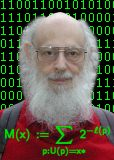| Eric Allender | Rutgers University, New Jersey, USA (AR) |
| Klaus Ambos-Spies | Universität Heidelberg, Germany (AR) |
| Eugene Asarin | Université Joseph Fourier, Grenoble, France |
| Luis Antunes | University of Porto, Portugal (AIT) |
| Maxim Babenko | Moscow State University, Russia (KC) |
| Janis Barzdins | University of Latvia (AIT) |
| Verónica Becher | University of Buenos Aires, Argentina (AR,KC) |
| Harry Buhrman | CWI and University of Amsterdam, The Netherlands (AR,KC) |
| Cristian S. Calude | University of Auckland, New Zealand (AR) |
| Gregory J. Chaitin | IBM Research, Yorktown Heights, NY, USA (AR,AI) |
| Alexey Chernov | Istituto Dalle Molle di Studi Sull'Intelligenza Artificiale (IDSIA), Lugano, Switzerland (KC,CC) |
| Thomas Cover | Stanford University, CA, USA (AIT,other) |
| David Dowe | Monash University, Melbourne, Australia (MML) |
| Rodney G. Downey | Victoria University, New Zealand (AR) |
| Bruno Durand | Université de Provence, Marseille, France |
| Allan Erskine | University College London, UK (ML,KC) |
| Santiago Figueira | University of Buenos Aires, Argentina (AR,KC) |
| Lance Fortnow | University of Chicago, USA (CC) |
| Péter Gács | Boston University, USA (AIT) |
| Alex Gammerman | Royal Holloway University, London, UK (AIT,ML) |
| Murray Gell-Mann | Santa Fe Institute, USA (AIT,other) |
| Peter Grünwald | CWI and Eindhoven University of Technology, The Netherlands (MDL) |
| Denis R. Hirschfeldt | University of Chicago, USA (AR) |
| John Hitchcock | University of Wyoming, Laramie, WY, USA (AIT,CC) |
| Achim Hoffmann | University of New South Wales, Australia (KC,Occam) |
| Günther Hotz | Universität Saarbrücken, Germany (AIT,CC) |
| Marcus Hutter | Australian National University, Australia (AIT,AP,AI,ML) |
| Yuri Kalnishkan | Royal Holloway University of London, UK (AIT,ML) |
| Bjorn Kjos-Hanssen | University of Connecticut, Storrs, CT, USA (AR) |
| Andrei Kolmogorov | Moscow, Russia (AIT) |
| Kevin Korb | Monash University, Melbourne, Australia (MDL) |
| Sophie Laplante | Université Paris-Sud, France (CC,KC,AR) |
| Tor Lattimore | Australian National University, Australia (AIT,AP,ML) |
| Troy Lee | CWI Amsterdam, The Netherlands (CC,KC) |
| Leonid A. Levin | Boston University, USA (AIT) |
| Ming Li | University of Waterloo, Canada (AIT) |
| Luc Longpré | University of Texas at El Paso, USA (KC,CC) |
| Jack Lutz | Iowa State University, USA (AR) |
| Jean-Yves Marion | LORIA Université Nancy, France (CC,KC) |
| Per Martin-Löf | University of Stockholm, Sweden (AR) |
| Elvira Mayordomo | University of Zaragossa, Spain (AR) |
| Wolfgang Merkle | Universität Heidelberg, Germany (AR) |
| Nenad Mihailovic | Universität Heidelberg, Germany (AR) |
| Joseph Miller | University of Wisconsin—Madison, USA (CC,KC,AR) |
| Philippe Moser | Iowa State University, USA (AR) |
| Andrej Muchnik | Institute of New Technologies, Moscow, Russia (AIT) |
| Andre Nies | University of Auckland, New Zealand (AR) |
| Jan Poland | Istituto Dalle Molle di Studi Sull'Intelligenza Artificiale (IDSIA), Lugano (AIT,ML) |
| Jan Reimann | Universität Heidelberg, Germany (KC,AR) |
| Jorma Rissanen | Almaden Research Center, San Jose, CA, USA (MDL) |
| Andrei Romashchenko | Institute of Problems of Information Transmission, Moscow, Russia (KC) |
| Boris Ryabko | Siberian State University of Telecommunication and Computer Science, Siberia (AR,KC) |
| Jürgen Schmidhuber | Istituto Dalle Molle di Studi Sull'Intelligenza Artificiale (IDSIA), Lugano, Switzerland (US,AIT,ML) |
| Claus-Peter Schnorr | Goethe-Universität Frankfurt, Germany (AR) |
| Robert Solovay | University of California, Berkeley, USA (AIT) |
| Alexander Kh. Shen | Institute of Problems of Information Transmission, Moscow, Russia (CC,AIT) |
| Theodor A. Slaman | University of California, Berkeley, USA (AR,CC) |
| Ray J. Solomonoff | Oxbridge Research, Cambridge, MA, USA (AP,ML,AI) |
| Ludwig Staiger | Universität Halle, Germany (AR) |
| Frank Stephan | Universität Heidelberg, Germany (AR) |
| Sebastiaan A. Terwijn | Technical University of Vienna, Austria (AR) |
| Leen Torenvliet | University of Amsterdam, The Netherlands |
| Boris A. Trakhtenbrot | Tel Aviv University, Israel |
| John Tromp | Formerly at the Dutch Centre for Math&CS and CWI, The Netherlands (CC,KC) |
| Maxim Ushakov | Moscow State University, Russia |
| Vladimir Uspensky | Moscow State University, Russia |
| Vladimir V'yugin | Institute of Problems of Information Transmission, Moscow, Russia (KC) |
| Michael Vyugin | Royal Holloway University, London, UK (KC,ML) |
| Nikolai Vereshchagin | Moscow State University, Russia (KC,CC) |
| Paul M. B. Vitanyi | CWI, Amsterdam, The Netherlands (KC,ML) |
| Volodya Vovk | Royal Holloway University, London, UK (KC,ML) |
| Chris Wallace | Monash University, Australia (MML) |
| Yongge Wang | University Heidelberg, Germany (CC,AR) |
| Osamu Watanabe | Tokyo Institute of Technology, Tokyo, Japan (CC,KC) |



